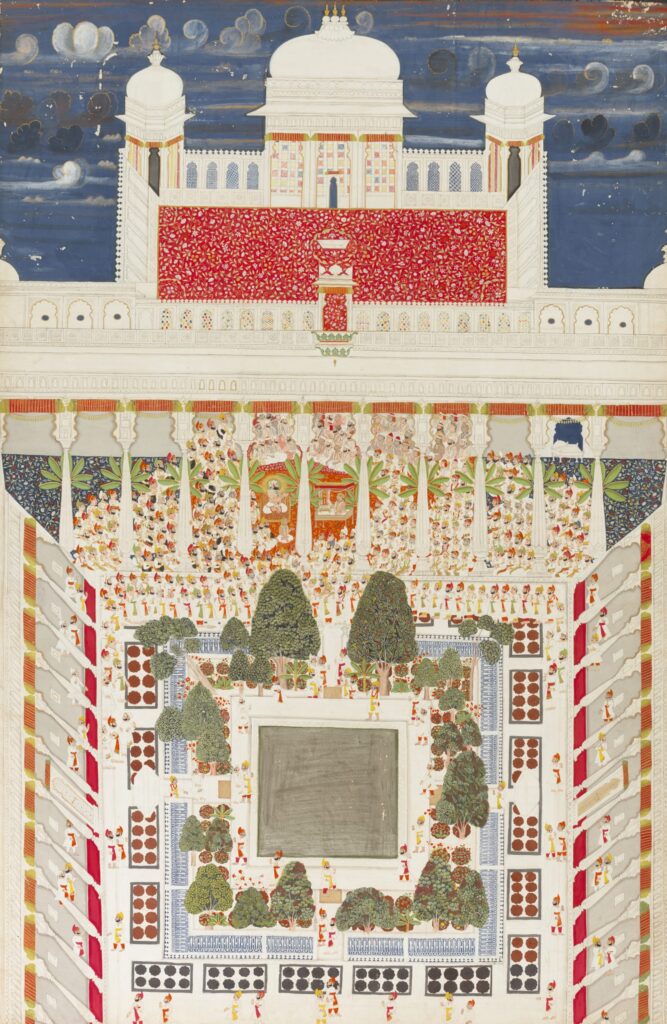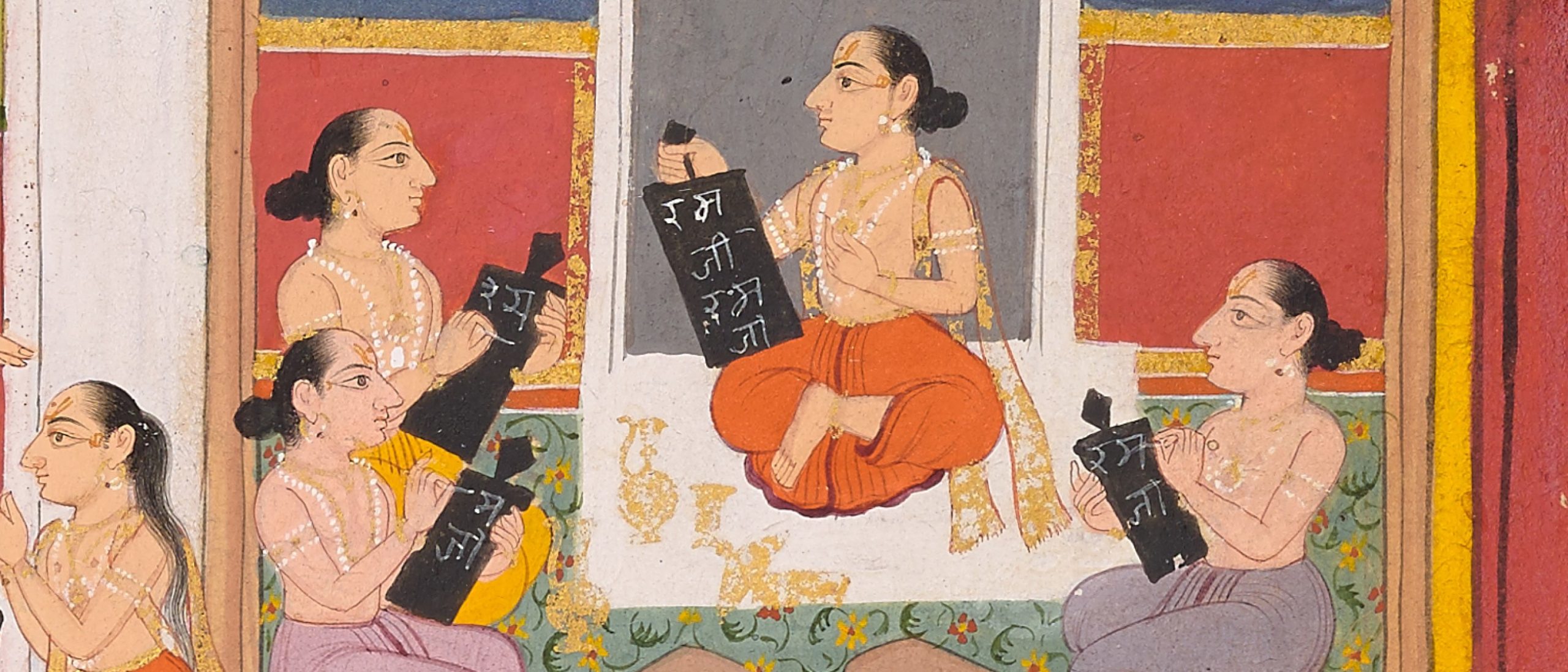November 19, 2022–May 14, 2023
-
Dates
-
Location
Arthur M. Sackler Gallery | Gallery 28
-
Collection Area
South Asian & Himalayan Art
Around 1700, artists in Udaipur (a court in northwest India) began creating immersive paintings that express the moods (bhava) of the city’s palaces, lakes, and mountains. These large works and their emphasis on lived experience constituted a new direction in Indian painting.
With dazzling paintings on paper and cloth—many on public view for the first time—the exhibition reveals the environmental, political, and emotional contexts in which the new genre emerged. A Splendid Land explores the unique visual strategies that artists developed to communicate emotions, depict places, and celebrate water resources.
The exhibition is organized as a journey that begins at Udaipur’s center and continues outward: first its lakes and lake palaces, then to the city, onward to the surrounding countryside, and finally to the cosmos. A side trip immerses visitors in the emotions surrounding the monsoon, the annual rains so crucial to Mewar’s prosperity. Throughout, a soundscape by the renowned filmmaker Amit Dutta invites audiences to fully sense—and not just see—the moods of these extraordinary places and paintings.
A Splendid Land: Paintings from Royal Udaipur will also be on view at the Cleveland Museum of Art in Summer 2023.
A Splendid Land: Paintings from Royal Udaipur is part of the 2023 programming marking the 100th anniversary of the National Museum of Asian Art’s founding. Learn more about our centennial celebrations. #TheNext100
Curator’s Cut
Exhibition Overview

Setting the Stage: Early Painting from the Udaipur Court
For a century—from 1605, the date of the earliest extant paintings from the Udaipur court, until around 1700—artists focused on small manuscript paintings. They conveyed the emotional resonance of sacred narratives and poetic verses through idealized forms and bold, saturated colors. In this folio from an illustrated Ramayana, the painter aroused wonder through fantastically imagined trees, a luscious palette, and the hero’s wide-armed gesture of amazed pleasure.

A Splendid Land
In the eighteenth century, Udaipur painters began creating immersive works unlike anything else in Indian art. Instead of painting small images of ideal worlds, artists turned to large depictions of lived events in local settings. They sought to convey the bhava—the emotional tenor and sensorial experiences—that make places and times memorable. By combining the local, the spatial, and the ephemeral with idealized portraits of Mewar’s kings, artists created a new genre.In a painting that evokes the mood of Udaipur at sunrise, clouds of scarlet, gold, and blue billow above the City Palace, its fortified walls, the nearby green hills, and the spectacular Lake Pichola. While the king protects the realm by hunting a tiger, urban dwellers and villagers go busily about their morning activities.

Worlds of Pleasure: Udaipur’s Lake Palaces
Within the dry, mountainous landscape of Mewar, Udaipur appears as a shimmering oasis. At its center are the island palaces of Lake Pichola: Jagmandir and Jagniwas.
Both palaces integrate thoroughly with their lake settings. Not only are they surrounded on all sides by water, but they feature pools and fountains in their gardens, are cooled by lake breezes, and have open arcades framing spectacular views.
These elegantly designed spaces became pivotal to cultivating bonds with noblemen and allies in the eighteenth century. They convey the atmosphere of refined pleasures (vilasa).
“Maharana Ari Singh II enjoying Jagmandir,” for example, builds a sense of pleasures savored at a meandering pace. The bird’s-eye perspective allows us to follow the maharana as he admires trees plump with pomegranates, shoots fish from a ceremonial window, and observes the feeding of crocodiles. His beloved is always at his side.

Monsoon Moods
In India, the monsoon is a mood with its own ambience. As the first rains fall, the searing heat lifts, the hills turn from brown to green, and the air, smells, and colors of the sky change.
Located in arid northwest India, in a region with only one perennial river, Mewar depended for its prosperity on annual monsoons. Tapping into the longing for rains, Udaipur painters celebrated the feeling of ebullient relief when the monsoon filled their city’s lakes and reservoirs.
“Maharana Fateh Singh crossing a river during the monsoon” evokes the mood of swelling rivers and drenching rain in an awe-inspiring valley. As lightning snakes across the sky, rain splashes on each horse, hill, and courtier. The painting memorializes an extensive inspection of the city’s water infrastructure that Maharana Fateh Singh and his courtiers undertook during the heavy monsoon of 1886.

The City Palace
Built atop a ridge on the east bank of Lake Pichola, the vast City Palace looks out over the streets of Udaipur. Construction of the City Palace began in 1553 with the founding of the city. Successive kings added new palaces and courtyards. Today much of the iconic cultural landmark is a public museum.Throughout the eighteenth and nineteenth centuries, court painters developed distinctive ways to convey the experience of being within and around the City Palace. Two paintings of the palace’s most cherished courtyard, the Baadi Mahal, reveal how artists experimented with multiple perspectives and multiple temporalities to accentuate moods of delight and devotion. Shambhu’s 1765 composition playfully transforms the symmetrical stone inlay of the courtyard into a syncopated pattern and sharply exaggerates the shadows cast by torches. Some seventy years later, Ghasi dynamically reconceived the Baadi Mahal’s monumental presence by rendering its side arcades at 45 degrees.

In the City
When artists switched, around 1700, from small paintings of poetic subjects to large paintings of Udaipur, they took on as subject the mood of the city itself. These paintings are notably inclusive, integrating the perspectives and experiences of city dwellers as well as of courtiers.This painter conveyed the atmosphere of the Gangaur festival as it developed over hours across the city. In the foreground, it is daytime. To honor the goddess Gauri, women throng Udaipur’s brightly lit streets, some bearing small images of the goddess to immerse in the lake. The distant city is dusky. At upper right, a group of townsmen fling themselves into the darkness away from a blazing firework, their backs lit up by its glow. Gold fireworks explode, leaving smoky trails in the sky and casting golden ripples on the lake’s surface.

Beyond the City
In Indian art, visual representations of local geographies are rare. But between 1700 and 1900, Udaipur artists produced hundreds of ambitious paintings that depict the mountains, rivers, and lakes around the capital city.Painters devised endlessly novel solutions to convey the mood (bhava) of remarkable men enjoying a remarkable land. To capture the feel and appearance of the local landscapes, artists physically traversed and rigorously plotted terrains, combining strategies from North Indian mapmaking with observations of the natural world.
“Maharana Jagat Singh II hunting tiger at Tikhliya Magra” boldly plays with perception and immersion. Depicted from above and bristling with texture, it invites viewers to repeatedly search the jungle, peer through brush, and circle crags in order to find the tiger, mirroring the process of stalking prey. In counterpoint to the hypnotic patterning, water plays an orienting role: Lake Pichola’s spiky fingers mark the route that the party took to the hunting grounds.

Heaven on Earth
In the eighteenth century, court artists depicted Udaipur as a heaven on earth. Not only did they represent Hindu gods gracing the lake-palace city, but they also envisioned divine realms as mirrors of royal Udaipur.The mood of Shri Eklingji temple, for example, affirms that the gods favor Udaipur. Its painter combined observed details, cartographic strategies, and tilted picture planes to map the site’s topography, underlining its importance as the site where Mewar’s first king received a divine blessing to rule. Steep gorges and large lakes surround the temple of Shri Eklingnathji, the dynasty’s tutelary deity. The elegantly elongated composition creates a mountain-kissing white temple that evokes Shiva’s heavenly abode in the Himalayas.

Curatorial Conversations
Based on new research into topics ranging from poetry to pyrotechnics, sensory experience to animal husbandry, explore these guided close-looking experiences for ten paintings created by students from the Institute of Fine Arts, NYU.
Further Learning
A Splendid Land (Intro essay), by Debra Diamond and Dipti Khera, A Splendid Land: Paintings from Royal Udaipur, Hirmer, 2022 (pdf)
Behind the Frame: Conservation at the City Palace Museum, by Anuja Mukherjee, Bhasha Shah, P. M. Vasundhara, Saloni Ghuwalewala, and S. Girikumar, A Splendid Land: Paintings from Royal Udaipur, Hirmer, 2022 (pdf)
A Splendid Land: Paintings from Royal Udaipur is available now at the museum shop (call 202.633.0503) and online through the University of Chicago Press.
Soundscapes by Amit Dutta
Soundscape 1 | A Splendid Land: Paintings from Royal Udaipur | View on YouTube
Soundscape 2 | A Splendid Land: Paintings from Royal Udaipur | View on YouTube
Soundscape 3 | A Splendid Land: Paintings from Royal Udaipur | View on YouTube
Public Programs
Public tours of A Splendid Land are offered every day. Please check our calendar for times.
- Curator Tour of A Splendid Land , November 19, 2022, 11:00am
- Concert: Melody of Lakes: A Musical Reflection on Udaipur’s Paintings, November 19, 2022, 1:30pm
- Curator Tour of A Splendid Land, November 19, 2022, 3:00pm
- Concert: Melody of Lakes: A Musical Reflection on Udaipur’s Paintings, November 19, 2022, 4:00pm
- Film Festival: Head Trips and Road Trips in India, December 2-18, 2022
- Panel Discussion: Monsoon: Histories and Futures, December 9, 2022, 1:00-3:00pm
- Panel Discussion: Yamuna/Anacostia: Rivers and Environmental Justice, December 10, 2022, 1:00-3:00pm
- Curator-Led Tour: The Power of Seasonal Moods: Monsoon to Spring, March 17, 2023, 11:00am-12:00pm
- Curator-Led Tour—Water: Place, Pleasure, Politics, April 25, 2023
- Curator-Led Tour—Mood Makers: Dancers, Cooks, Poets, and Painters, April 30, 2023, 1:00pm-2:00pm
- Docent Tour of A Splendid Land, daily during run of show (see events calendar for details)
Related Publication
A Splendid Land: Paintings from Royal Udaipur
Author List: Debra Diamond (ed.), Dipti Khera (ed.), and contributors
Publisher: Hirmer Publishers; National Museum of Asian Art, Smithsonian Institution
Publication Date: February 19, 2023
A lavishly illustrated volume that explores the immersive aesthetics and emotional resonance of paintings from the lake city of Udaipur. Around 1700, artists in Udaipur began creating large, immersive paintings to convey the mood of the city’s palaces, lakes, and mountains. This exhibition catalogue opens up new interpretative possibilities by displacing the figure of the king to examine social networks, cultural landscapes, pleasure, and politics; by drawing upon previously untranslated sources; and by engaging with the latest scholarship on the history of the senses.

Support
A Splendid Land: Paintings from Royal Udaipur is organized by the Smithsonian’s National Museum of Asian Art in collaboration with the City Palace Museum, Udaipur administered by the Maharana of Mewar Charitable Foundation. The exhibition celebrates the Centennial of the National Museum of Asian Art and the 75th year of India’s Independence.
The National Museum of Asian Art gratefully acknowledges support from members of the A Splendid Land: Paintings from Royal Udaipur Leadership Council.
LEADERSHIP COUNCIL
Exhibition Co-chairs
Farhad and Mary Ebrahimi
Dr. Vijay and Ms. Nanda Anand
Exhibition Benefactors
Nancy Swift Furlotti (Pettit Foundation)
Nancy Chang Lee
Exhibition Sponsors
Dr. Susan L. Beningson and Steve Arons
The Honorable and Mrs. William A. Nitze
Iris and Lawrence Miller
Dr. Bruce Chalker and Dr. Polly A. Penhale
Ms. Elizabeth Gomersall
Ashok and Stuti Kaveeshwar
Jane Washburn Robinson
Additional support is provided by the Elizabeth Moynihan Curator of South and Southeast Asian Art Endowment, The Ashok and Marion Deshmukh Endowment for South Asia, Smithsonian’s Scholarly Studies, and the Smithsonian Women’s Committee.
Bank of America is the Presenting Sponsor of the Smithsonian’s National Museum of Asian Art’s Centennial.

"Sunrise in Udaipur", 1722–23. Udaipur. Opaque watercolor and gold on paper; 82.3 × 152.4 cm. The City Palace Museum, Udaipur, 2012.20.0015 (Detail)
- Jump To...



